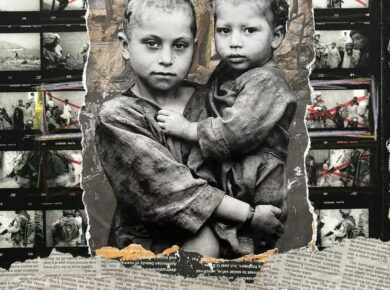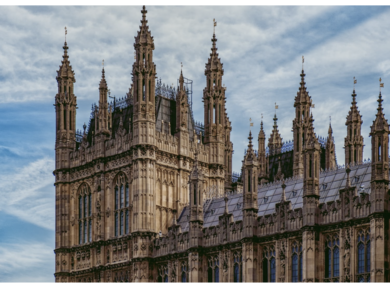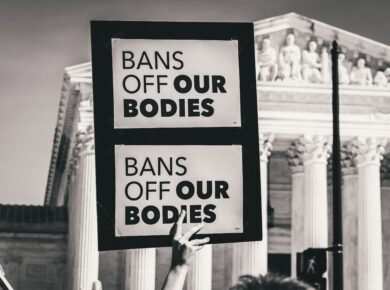Photo source: The Texas Tribune
Disclaimer: This blog post solely reflects the opinion of the authors and should not be taken to represent the general views of IPPR’s management team or those of fellow authors.
With the culmination of Super Tuesday further narrowing the Democratic primary competition, “Bernie or Biden?” has seemingly been the question of the week. Often forgotten, however, is that the ability to vote, the ability to consider and act on that question, is not universal.
Despite the existence of the 14th amendment which guarantees “equal protection of the laws”, recent restrictions on voting rights established by states have created a situation that is anything but equal. One notoriously racially discriminatory legislative trend among states has been the creation of voter identification laws. According to the NSCL, as of 2019, 35 states have established voter ID laws that require people to present a form of approved ID upon arriving at the polls. On the surface, it seems like no big deal. What’s wrong with people simply flashing their driver’s license to the poll clerk before casting their vote? This couldn’t be farther from reality. Voter ID laws are racially discriminatory and disenfranchise people of color. This is established in three ways: 1) the forms of ID people of color have are more likely to be considered “unacceptable” 2) people of color are more likely not to have an ID at all and 3) the justification for enacting voter ID laws has been rendered irrational repeatedly.
On the first point, it’s important to note that there are restrictions on the type of ID that can be presented—the ACLU reports that seven of the 35 states with voter ID laws require voters to “present one of a limited set of forms of government-issued photo ID in order to cast a regular ballot—no exceptions.” Frequently, the list of acceptable IDs used by states is inherently discriminatory. Some notable cases documented by the ACLU include Texas’s law that concealed weapons permits are allowed but student ID cards are not, and North Carolina’s regulation that leaves public assistance and state employee ID cards off of the approved list. Given that black voters, according to the ACLU, are more likely to have the aforementioned unacceptable IDs such as state employee cards, while white voters are more likely to have the accepted ones such as concealed weapons permits, this places black voters behind white voters considering that they are more likely to be turned away at the polls for not having the right ID. This itself, is concerning considering that voter apathy in the United States is already low given their self- proclaimed “leader of the free world” democracy status. In fact, the U.S. Census Bureau found that voter turnout among eligible voters in the 2016 election was only around 61.4%. Turning people of color away at the polls just because they don’t have the right “selected ID” is going to exacerbate this issue—it is more likely to discourage people of color from voting and push down even further the level of black representation in the electorate. Research on the effects of voter ID laws supports this claim too: the 2014 GAO study warned that turnout reduced by 2-3% in states with voter ID laws, with a “particularly depressive effect on turnout among racial minorities.” If people already do not have faith in the political system, being told that they can’t vote after coming all the way to the polls on election day will solidify their concern.
Further, people of color are more likely not to have any form of ID to present in the first place. According to the Brennan Center for Justice, 11% of U.S. citizens (which accounts for more than 21 million Americans) do not have any form of government issued ID and “25% of African-American citizens of voting age lack government-issued photo ID, compared to only 8% of whites.” Another 2018 study found that “non-white voters are between 2.5 and 6 times more likely than white voters to lack photo ID.” Moreover, Stephen Ansolabehere from Harvard University and Eitan Hersh from Tufts University also stressed that while 7.5 percent of black registered voters were missing from federal ID databases only 3.6 percent of white voters could say the same. These data demonstrate that lacking government ID is not a random issue in the American electorate—it is divided on racial lines and thus cannot be ignored. Proponents of voter ID laws often argue that those without ID can always apply to get one, but research suggests otherwise. A report from Harvard Law School stresses that obtaining an ID is quite costly—the total cost could range from $75 to $175. This essentially puts a price tag on voting. Given that blacks, as proven by the Brookings Institution, are disproportionally represented in lower socioeconomic groups, this will in turn restrict a greater number of black people voting than white people simply because they can’t afford an ID.
The argument against voter ID laws would be legitimately challenged if fraudulent ballots were significantly impacting elections. This, however, is not the case. In fact, the threat of at-the-polls voter fraud is close to none. The Washington Post reported in 2014 that since 2000 there have been over a billion ballots cast and of that there were only 31 credible cases of voter fraud. That means voter fraud in this form has only taken place 0.000031% of the time. It is safe to say that 31 cases over the span of 14 years certainly would not have changed the outcome of any elections. So, then begs the question—what is the purpose of voter ID laws if in-person voter fraud is not even an issue? I would argue, it is racial discrimination.
The racial inequity presented by voter ID laws is indirect. And, thus, as I will later show, is more dangerous. Blatantly racist actions are usually quick to be condemned by the public today. From the reactions against Trump’s tweet telling four democratic congresswomen to “go back” to the “inept” countries from which they “originally” came to the public condemnation of violence in Charlottesville after the Unite the Right rally, the general public usually takes a stance against obvious racism. More subtle forms of racism like voter ID laws, however, receive less sympathy and widespread attention, allowing racist laws to continue to be passed and supported. Hutchings and Valentino elaborate on this trend in their paper The Centrality of Race in American Politics. They argue that “coded language allows candidates to endorse negative racial stereotypes without violating either deeply felt norms of equality” and “quite common, however, and perhaps even more effective at least among white audiences, are implicit racial appeals—those that activate attitudes about black people without mentioning them directly.” This is exactly what is happening in the case of voter ID laws. Legislators are able to pass such laws with—according to the Pew Research Center—an 80% approval rating under the guise of it protecting against voter fraud even when such a problem, as proven earlier, does not even exist. People feel confident in buying this claim because it is advertised as policy that allegedly protects democracy, and thus in accordance with Hutchings and Valentino’s claim it doesn’t violate “deeply felt norms of equality.” Proponents of voter ID laws do not call out black voters explicitly as those they want to deter from voting, but implicitly alienate them by creating a barrier to voting on racially divided lines. Thus, I would argue this implicit racism is even more dangerous than blatant racism because it receives considerably less attention, if it is recognized at all.
While, of course, not everyone who supports voter ID laws has intentionally racist motivations, whether people realize it or not, there is a clear racial hierarchy that exists within American society that likely fuels their support of such laws. As Masouka and Junn postulate in their paper The Politics of Belonging, the racial hierarchy forms a diamond: whites on top, hispanics and asians in the middle, and blacks on the bottom. Thus, if we look at the problems caused by voter ID laws through to lens of Masouka and Junn’s Racial Prism of Group Identity it becomes clear why people are so keen on enacting them despite the evidence that suggests they do more harm than good. The RPGI argues that racial hierarchy determines political views and that the racial order remains at the center of politics. Given that people of color are more likely to vote Democrat, the Republican Party—which according to the Economist, typically supports such laws—lacks the significant non-white base to feel the adverse effects voter ID laws have during elections. In fact, Gallup reports that the Republican Party is about 89% white. This white base that makes up the majority of republicans don’t see voter ID laws as an issue because they are at the top of the hierarchy and are only seeing the world from that perspective. If the RPGI determines political views, then their view is shaped by “whiteness”—because they have not experienced disenfranchisement for something as arbitrary as lacking the right ID to vote, they don’t understand the gravity of such laws.
Voter ID laws are not the first and, unfortunately, will likely not be the last form of indirect legal racial discrimination. The prevalence of “coded” racist policy and language is a much wider problem, that given how deeply the RPGI is ingrained in society, will take many years if not decades more to overcome. That should not dishearten us from making a start though. The path to overcoming systemic racism in society starts with recognition. It starts with people making the effort to look beyond the surface level of our policy—understand the effects and assess the validity of the claims being made about it. As Americans, we have a duty to understand our rights and ensure their protection. A duty to prevent this violation of equal opportunity from continuing. So, write to your representatives, spread awareness online and among your circles, petition state legislatures that have enacted voter ID laws, and make your stance against systemic racism heard. Then, one day, hopefully we can truly believe that our government protects liberty and justice for all.
By Sanjana Balakrishnan
BSc Politics and International Relations Undergraduate







